Reproduction methods
Weigela reproduces well by sowing seeds, rooting cuttings and layering. It is worth noting that in order to get a varietal beauty, you need to propagate it only by cuttings or layering. The resulting seedling will retain all the characteristics of the mother plant, and the first flowering will occur in 2-3 years. Sowing seeds is used in cases where you need to immediately get a large amount of planting material, but such seedlings will bloom only after 5-6 years and, possibly, will differ from the parent in appearance.
Sowing seeds
Sowing seeds is best done in a specially designated school, where the plants can stay for three years, since only a three-year-old seedling can be planted in a permanent place. It is advisable to fence off a small bed (school) with bumpers, install arcs and cover with agrofibre. Such a greenhouse will protect seedlings from wind, sun and moisture loss.
Weigela seeds germinate well if sown in the harvest year. Sowing can be carried out in the spring, after the soil has completely warmed up - usually this is the second half of May. Podwinter sowing also gives good results. It is more often carried out in November, after the first frost.
Weigela seeds in the year of harvest have almost one hundred percent germination, but over time it decreases
Spring sowing of seeds:
- The day before sowing, spill the bed abundantly with a solution of phytosporin.
- Spread weigela seeds on a leveled surface.
- Sprinkle on top with a small layer of moist coconut substrate, peat or sand and compact.
- Close the greenhouse tightly with agrofibre.
It will be necessary to moisten the crops for the first time every day. It is most convenient to use a spray bottle so as not to wash off the seeds. Seedlings will appear in 3-4 weeks.
Sowing seeds before winter:
- After the first frost on the prepared bed, spread the seeds.
- Sprinkle with a light layer of peat or coconut substrate.
- Cover the planting from above with sawdust, straw or agrofibre.
- In the spring, remove insulation from the garden and make a greenhouse with arches.
The sprouted seedlings are carefully thinned out. No need to pull out extra shoots - it is better to cut them off with scissors.
Weigela can be sown in containers and grown at home. In the summer, the seedlings are transferred to the garden, choosing a quiet, shady place for them.
By cuttings
Good terms for cuttings are March and May-June. In the first case, cuttings are cut from lignified last year's shoots, in the second from semi-lignified young growths.
Rooting step-by-step process:
- Cuttings about 10 cm long are cut from the cut shoots. In summer cuttings, two upper leaves are left, shortening them by half, the rest are removed.
- The box is filled with a 1: 1 mixture of peat and sand.
- Sections of cuttings are dusted with root powder.
- Depressions are made in the soil with a stick at a distance of 10-15 cm from each other.
- The stalk is 2/3 immersed in the holes and pressed against the ground.
The lower leaves of the weigela cuttings are removed, and the upper leaves are shortened to reduce moisture loss
If grafting occurs in the summer, the container is taken out into the garden and placed in a greenhouse under agrofibre or film, but with mandatory ventilation. When rooting in spring, the cuttings are placed in a bright, warm, but non-sunny place in the room.
When the seedlings start growing, we can assume that rooting was successful. They are planted in separate pots and young shoots are pinched. Emerging buds must be removed so that the strength of the plant goes to the formation of roots.
Further care of the cuttings does not cause any difficulties. The main requirements are a shady, windless place, timely watering and feeding.Any mineral and organic fertilizers are suitable for flowers that are applied in turn.
Rooting cuttings
The easiest and most reliable way to propagate weigela is by rooting layers.
In early spring, before bud break, a shoot is chosen that is a short distance from the ground. Loose fertile soil is poured under it with a mound.
Rooting order layering:
- In the place where the branch will touch the ground, the bark is slightly scratched to speed up the formation of roots.
- The shoot is bent down, secured with a hairpin and covered with soil.
- Slightly moisten and cover with a film - the soil in this place should always be moist.
A weigela branch bent to the ground will take root and sprout during the summer
Over the summer, the cuttings will take root and already next spring it can be separated and planted in the school.
Possible growing problems
Weigela is an unpretentious plant and does not cause much trouble when growing. Sometimes it happens that a planted plant develops normally, but does not bloom in due time. It is difficult to say what is the reason, but often, after transplanting, the shrub comes to life and pleases the owners with bright flowering. Perhaps the location was poorly chosen, or the composition of the soil did not suit the plant.
Of the pests, aphids, spider mites or caterpillars can attack the weigela. At the first signs of insects, it is necessary to treat the shrub with an insecticide. Today on sale you can find a huge amount of pesticides for all occasions. However, it is worth giving preference to biological drugs such as Fitoverm, Akarin, Iskra-Bio - they bring no less benefits than their poisonous counterparts, however, they do not harm the environment
It is only important not to spray the plants with these preparations during flowering, so that the bees do not suffer.
Subtleties of care
Weigela, planted according to all the rules, will not cause much trouble in care. A young plant will need slightly more frequent watering during survival. Watering is best in the morning or evening with water at room temperature. Mulch with a layer of 8–10 cm will significantly reduce labor costs, since moisture remains under it longer, which means you can water less often. Weeding and loosening on a mulched surface is also practically not needed.
Top dressing
If the planting pit was filled with fertile soil with fertilizers, then the first two years of feeding the plant are not needed.
Further fertilization:
- in early spring, a mineral complex fertilizer containing nitrogen, phosphorus and potassium is applied;
- with the beginning of the formation of buds, the bush is fed with phosphorus-potassium fertilizers, which will provide a long bright flowering and prepare the shoots for winter;
- the third time fertilizers are applied in the fall, for digging, scattering 150 g of ash and 250 g of dolomite flour or autumn mineral fertilizers in the amount recommended by the manufacturer around the perimeter of the trunk circle.
In spring and summer, it is better to apply top dressing in liquid form, diluting the fertilizer in water - this way the plant will receive the necessary nutrients faster. It is better to do this after watering or rain to avoid scalding the roots.
Pruning features
Like many ornamental shrubs, weigela needs pruning. Broken and frozen shoots are removed from young plants in early spring. Adult bushes require pruning after flowering - all faded shoots are shortened, and if this is done on time, then the young growths will have time to bloom at the end of summer. Re-flowering will not be as lush as the first, but it will also decorate the bush and delight the owners.
Aging weigela bushes will need rejuvenating pruning, in which young shoots are shortened by about 1/3, and branches older than 3-4 years are completely removed. Sometimes gardeners cut off all shoots, and the shrub easily tolerates such an operation.

Removing old, thickening branches rejuvenates the shrub and promotes flowering
Preparing for winter
In most of our country, weigela needs to be sheltered for the winter. Without shelter, the shrub will survive the winter only in the southern regions, where the thermometer rarely drops below 0 ° C. Here it is enough to put a mound of earth 20–30 cm high around the plant and mulch it.
Weigela's frost resistance increases with maturation, therefore young shrubs are especially carefully covered. Before the onset of frost, prepare the trunk circle - weed, loosen and cover with dry soil, with a layer of at least 20 cm.Mulch with straw or sawdust on top.
Plants begin to shelter directly after the first frost. This should be done in dry weather, as humidity can lead to rotting shoots and the appearance of mold.
For shelter over a bush, weigels construct a frame or crate and wrap it with agrofibre or burlap in 2-3 layers. From above, the structure is covered with a film and securely fixed. This must be done so that, during possible thaws and rains, water does not penetrate inside, but at the same time there remains air access. It is good to use hydro or vapor barrier for these purposes, which are sold in all hardware stores. This material allows air to pass through and at the same time repels water.
If the weigela shrub is short, you can try to bend the branches. To do this, the plant is wrapped in burlap or agrofibre and tilted to the ground. Straw, spruce branches, dry leaves are placed under the branches and fixed with arcs. From above, the structure is also insulated with any available material and covered with a film.

Weigela mixborders hideout resembles tunnels
Weigela: planting and care
Weigela should be planted in places well protected from the wind, preferably in a sunny location, but under openwork crowns in a group of trees, it will also feel great. Moreover, landing in groups for weigela is preferable, since in them it is better protected from the wind and snow is better delayed there in winter.

Weigela
The soil prefers loose, humus, although weigela Middendorf grows well on peat bogs. Weigela prefers moderate watering, does not tolerate waterlogging, is responsive to feeding. Complex mineral fertilizer is applied in early spring - in the snow and in the first half of summer (not later than early August) during the period when flower buds are laid. You can make additional feeding with phosphorus-potassium fertilizers in September to accelerate the lignification of cells and the formation of flower buds, which in turn allows the plant to better endure the winter.
Weigela pruning is carried out immediately after flowering, while shortening the faded branches. In the spring, you can do sanitary pruning by cutting out dry and frozen shoots.
Weigela shelter for the winter
This factor is more related to care, however, it is important, it is worth mentioning separately. As mentioned above, young representatives who have not reached the age of three require special attention. With the arrival of winter, they must be covered.
In the Kuban, weigela is not sheltered for the winter. Well, if only in the first year, if the planting was carried out in the fall. It is enough to build a hut from the branches on top and pull on lutrasil, spunbond or any other covering material. It is better not to use plastic wrap, since the seedling may simply suffocate and in the spring you will receive non-viable branches that have become unviable from excess moisture. In recent years, the Kuban winters are mild, without sharp fluctuations in temperature. I think that in such conditions a mound of earth at the base of a bush can serve as a shelter. This will be enough to protect the roots from freezing.
And in central Russia, by about the end of October, the weigela shrub sheds its foliage. By this time, it is recommended to fill its near-trunk area with soil. You should have a small mound, about 20 cm high.The branches can be neatly tied and bent to the ground, then cover the shrub with protective material and fix.
Additional cover of the weigela with plastic wrap will not hurt only if the winter is expected to be especially harsh. But it is laid on top of an already formed structure and necessarily on top of an air-permeable covering material. This will protect the structure from the formation of condensation on the film. The ends of the film or covering cloth are reliably pressed with something heavy (bricks, stones or even metal staples) so that the wind does not rip it off.
You can also tie the branches (not too tight) and install a wire frame specially made for this purpose. The frame can be made of plastic or metal mesh. It is covered with Lutrasil or Thermoselekt; for greater reliability, dry leaves or coniferous spruce branches are poured inside - they provide additional heat.
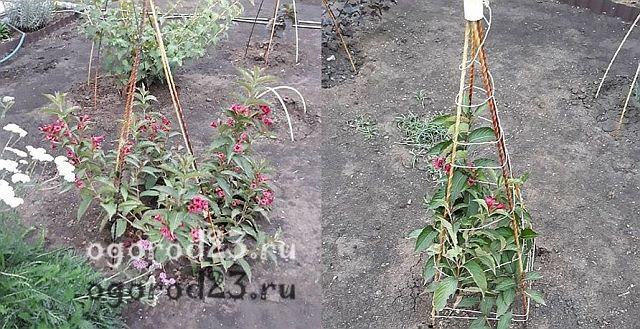
This procedure has certain nuances - it should not be wet in the insulating "cocoon", because moisture is the way to activate fungi. Air access is also very important; without it, shrubs can die.
Weigela shelter should be carried out in dry and cold weather, when the soil freezes a little. Do not put protective material on wet ground - later the plants will rot or get wet.
If everything is done correctly, then the shrub will safely survive the winter cold, and in the new spring it will delight you with its lush color. In warm regions with a mild climate, you can do with hilling, mulching or covering the shrub with spruce branches.
An excellent solution for decorating a summer cottage or local area is weigela. Photos and descriptions of the shrub, I think, will convince you of the beauty of the plant. Planting and care in the open field, as you can see, does not imply super-complicated tricks and agrotechnical tricks. Adhere to certain requirements in relation to this highly decorative shrub, then with the arrival of each spring, the blooming result of your efforts will give joy and beauty.
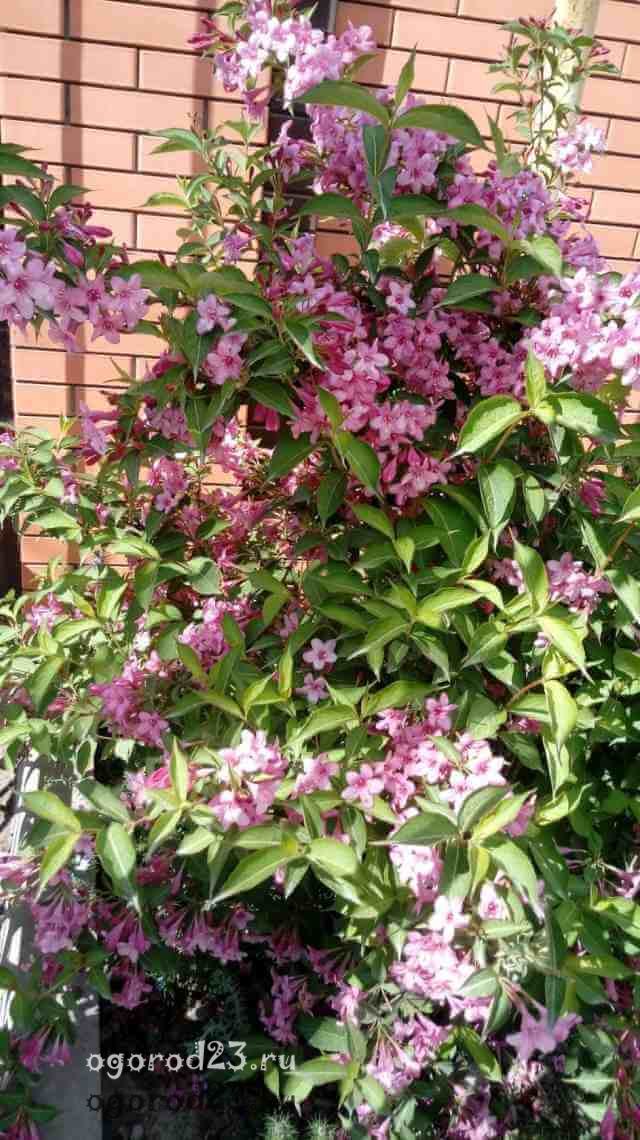 Photo by Galina Saprykina from Anapa, Krasnodar Territory
Photo by Galina Saprykina from Anapa, Krasnodar Territory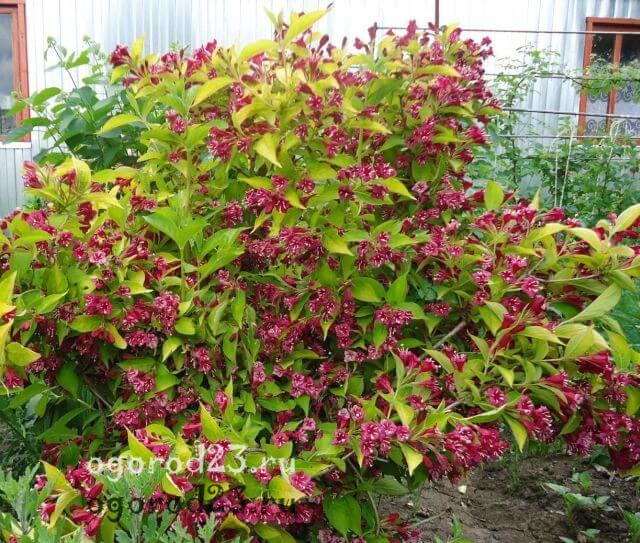 Photo of Lidia Fedorovna from Belorechensk, Krasnodar Territory
Photo of Lidia Fedorovna from Belorechensk, Krasnodar Territory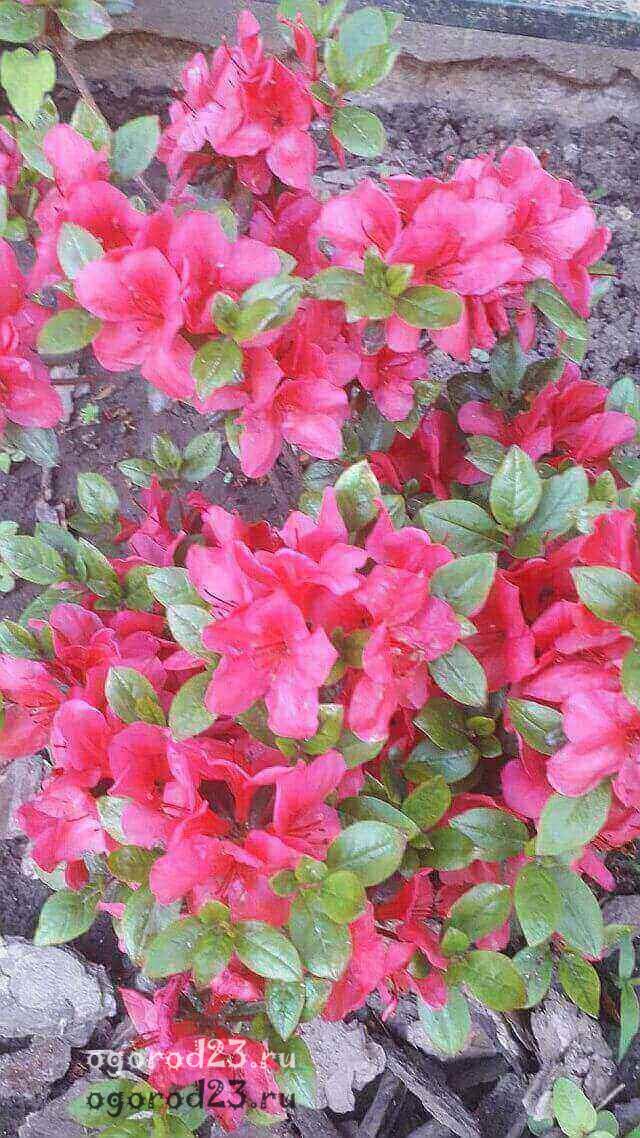 Photo by Elena Popravko from Art. Novotitarovskaya Krasnodar Territory
Photo by Elena Popravko from Art. Novotitarovskaya Krasnodar Territory
How to plant a plant correctly?
To ensure the survival and further high-quality growth of the bush, you need to know some rules for planting weigela in open ground.
Site and soil selection
In the conditions of the middle lane, the priority for planting is a slight elevation, without drafts, so that the buds do not fall off. The south side of the building is best suited.
The soil should be loose, rich in humus. It is best suited soil with admixtures of clay, slightly alkaline or neutral.
Landing in open ground
The planting hole is dug so that the roots fit comfortably in it. If a drainage layer is meant, the depth is increased. A nutrient layer of 1.5 buckets of compost and 100 g of nitrophosphate is laid on a layer of gravel (sand). The roots are carefully straightened, set in the center of the pit, gradually covered with earth and tamped. The root collar is deepened by 10-20 cm, then watered abundantly.
Varieties with bushes no higher than 1 m must be planted at a distance of at least 80 cm.Large plants should be up to 2 m apart from each other.
Weigela is easy enough to grow. You don't need to take special care of her. It all comes down to proper watering, spring feeding, during flowering and preparation for wintering. If necessary, pests should be destroyed and the bush treated.
Watering and feeding
Water the weigela, if necessary, with plenty of water if the days are dry. To enrich the soil with oxygen, shallow loosening should be carried out so that the roots do not suffer from mechanical stress.
The first time this is done in the spring, adding fertilizers rich in minerals such as potassium, nitrogen and phosphorus to the soil.In May-August, re-feeding is carried out, associated with the flowering period. For the active development and bright color of the buds, the shrub will need potash fertilizers with phosphorus. It will also give strength to the stems, allow them to stiffen faster and help the plant survive the winter chills.
The third top dressing should be carried out during the autumn digging, simply sprinkling the soil with wood ash at the rate of 100 g per 1 m².
How to trim correctly?
It is necessary to cut the weigela in several cases - for crown formation, for sanitary purposes and for rejuvenating a more than three-year-old bush.
Sanitary pruning is recommended for young bushes in the spring, removing diseased and dead branches after wintering.
When pruned, an adult weigela is formed to the required beautiful appearance. Such processing should be carried out immediately after the first flowering, preferably in the middle of summer. During this period, young shoots are not yet growing, only last year's and woody stems are shortened.
Pruning weigela after flowering in the fall is not carried out, since young branches are actively growing. In this case, it is better to postpone the procedure to the next year.
Shrubs over 3 years old require rejuvenating pruning to remove old thick stems. Younger ones are shortened by a third. Sometimes some gardeners completely bare the bush, after which the whole plant is quickly restored, but it will bloom weakly in the first year after such treatment.
Diseases and pests
Weigela can suffer from caterpillars and aphids. In the hot dry season, thrips and spider mites sometimes appear on the leaves. To combat such pests, it is necessary to use pesticides or more environmentally friendly infusions of garlic, hot pepper, wormwood.
If the leaves on the bush begin to fade and turn yellow, this may indicate that a bear or May beetle larvae have started up in the roots. In order to get rid of the destructive pest, you should water the bush with a solution of karbofos.
How to prepare a shrub for winter?
Although weigela is quite frost-resistant, before the onset of cold weather, it is necessary to think about protecting the crown, especially during the lowest temperatures.
Immediately after the foliage has fallen, a mound 15-20 cm high is poured around the plant. The branches are pressed to the ground as much as possible and fixed. You can tie them tightly with twine or rope. Roofing material or spunbond is laid on top of the lowered or connected bushes, pressing the edges of the canvases so that they are not blown away by the wind.
Dry leaves are poured inside the resulting shelter, and a warm covering material is laid on top. Such protection will save the life of even young shoots in the most severe frosts. It is necessary to remove the shelter in the spring, when there is still snow, leaving dry leaves before the onset of warm days.
Weigela in garden design
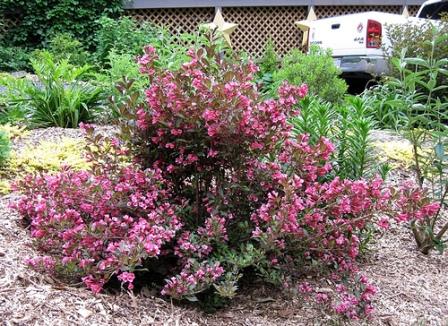
Weigela in the garden
In landscape design, weigela is very widely used due to its versatile decorativeness. She has a beautiful dense leafy crown, and the leaves can be different not only in texture, and very beautiful flowers of various shades - from white to purple. It is amazingly good as a tapeworm on a green lawn, but, unfortunately, a single planting of weigela is very vulnerable in our climatic conditions. Weigela looks no less original on the edges next to tall trees, in groups of ornamental shrubs and against the background of conifers. Low-growing varieties are used in mixed mixborders along with perennial and bulbous plants - dwarf irises, decorative onions, pale blue forget-me-nots and other spring flowers.
Such a high decorativeness of weigela, despite its delicacy and finickyness, makes it a welcome guest in the gardens of true connoisseurs of beauty and gardeners in love with their work.
2010 - 2018, Planting a Garden. All rights reserved.
Weigela care
Weigela does not tolerate drought well, so regular watering is one of the conditions for proper care.I try to systematically weed and loosen the soil to provide the plant with all the conditions for normal growth.
Pruning should be included in the care package. I spend it in two stages: immediately after thawing the ground - before the growing season, and at the end of the season. In the spring, I carry out sanitary pruning, remove frozen twigs, deformed shoots. Autumn is the best time to create a bush shape.
After the weigela has faded, it is necessary to prepare for the winter. I sprinkle the near-trunk zone with a layer of soil about 15 cm high. I carefully tie the branches, and in case of severe cold weather, I cover them with any covering material.
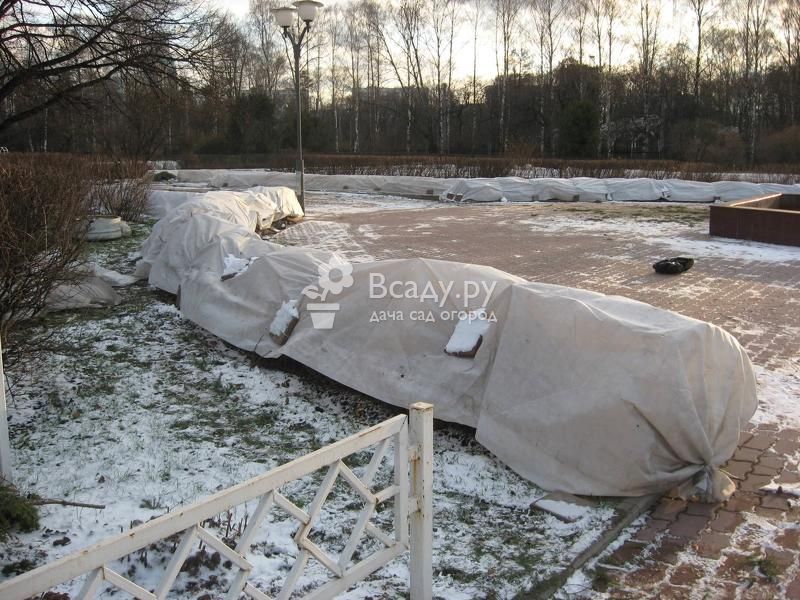
You will find detailed information on growing weigela in the garden in this article.
Weigela is a beautiful shrub that can decorate any garden plot. Observing the rules of planting and care, you will get a spectacular plant blooming with bright flowers.


